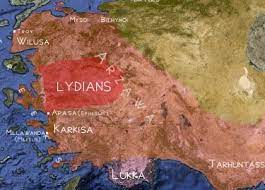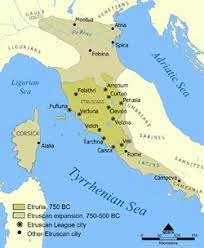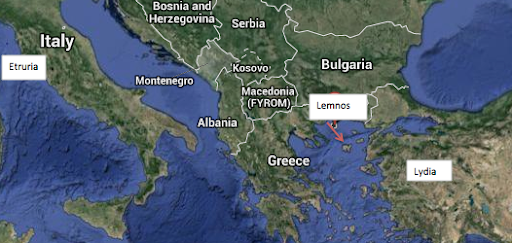According to Herodotus, it was the Lydian migrants to Italy round 900
BC who became the Etruscans. These were probably sailors attracted to
Italy by deposits of metal-bearing ores.
The Greeks formed one ancient society which owed much to the others.
Their successes must be measured -against the achievements of other
peoples, principally those of the Pelasgians. The debt which the
Hellenes owe to them has to be recognized.
The Pelasgians similarly have links with the Maeonians or Lydians.
These people emigrated, at a date somewhere between 1000 and 800 BC,
towards Umbria or Etruria where they became the Etruscans, as
Herodotus records. Neither Indo-Europeans nor Semites, they can be
numbered among the peoples who, a thousand years before, became the
Pelasgians. The Etruscan language, related to that of the Lycians and
Lydians, has not yet been deciphered.


The Maeonians had attained a high degree of civilization long before
they emigrated. They brought from Asia the double-headed axe-an emblem
of royalty, which subsequently became the symbol of State used by
high-ranking Roman magistrates.
During the eighth century BC the Etruscans formed a large and powerful
state in the centre of the Italian peninsula. They built fortified
towns, worked in metal, extracted minerals in Sardinia and Corsica,
and devoted themselves to a prosperous economy. Women had a high
status in their society.
Having annexed Rome at the beginning of the sixth century, the
Etruscans provided it with three kings, of whom the first and the
third were called Tarquin. Tarkhon is the name of an Anatolian god who
was worshipped by the Etruscans. It was Tarquin the Old who ordered
the construction of Rome’s first drains (the Cloaca Maxima) which are
still in use to this day. Urban drainage was a practice that the
Anatolians learned from the Sumerians.
Working in gold was one of the arts at which the Etruscans excelled.
In the Museum of Etruscan Art at the Villa Giulia in Rome one can see
gold filigree bracelets almost identical to those made and sold even
now in the historic Grand Bazaar in Istanbul, which are typically
Anatolian.
The role of the Etruscans in the civilization of Rome has long been
just as misunderstood as the contribution made by the Pelaseians to
Greek civilization, though Dante did lay claim to having had Etruscan ancestors.
The flow of migration from Anatolia towards the west has involved
other peoples in a similar way. The Sardians colonized Sardinia, and
the Sicels settled in Sicily. As to the legend that the Romans were
descendants of the Trojans, that could possibly be explained by
migrations of Lydian origin.
Source: Turkey in Europe & Europe in Turkey Turgut Òzal




















